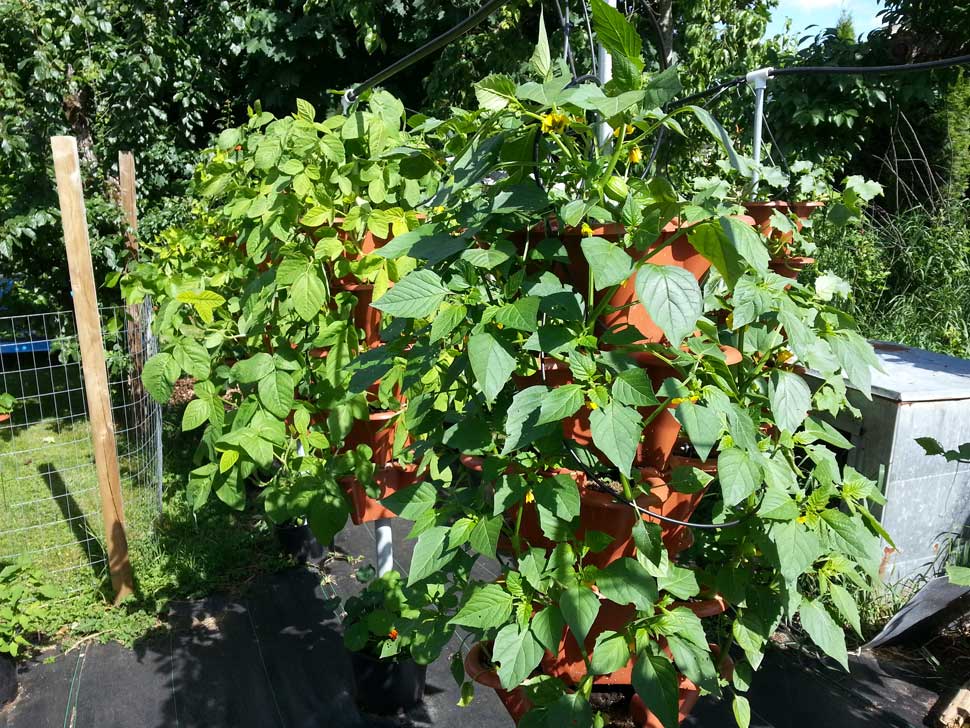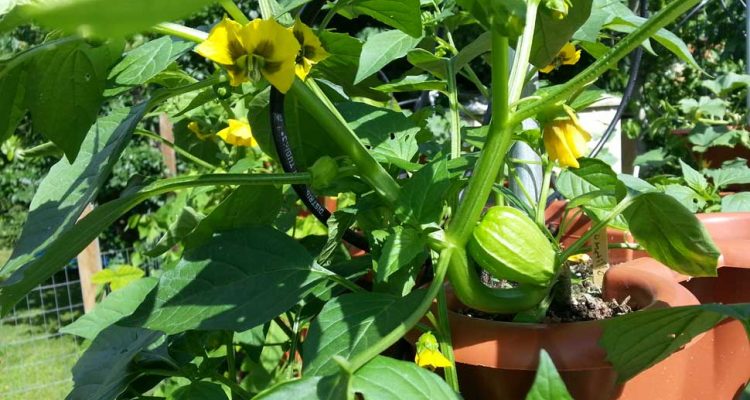Tomatillos? All great ‘salsa verde’ begins with fresh tomatillos. So, adding these is must if anybody at home likes this sauce with Mexican food. In our case, Mexican food is eaten more than once week and tomatillos are almost an essential part of summer and autumn meals.

This article could be cut very short and linked to one about tomato growing, since caring for Tomatillos are almost identical to that of tomatoes.
Growing Tomatillos From Seed
Tomatillo seeds can be purchased from seed supply houses. Some varieties of tomatillos are Siquieros, Tamayo and Toma Verde.
Once we have them, we can place a seed or two in each cell. 72-cell flats work great with a soaked peat/vermiculite mix, then seed, then a light 1/16-1/8 inch vermiculite cover.
A mister can be used to lightly moisten the top vermiculite layer, or capillary action from the peat/vermiculite mix will eventually saturate it too.
Once the seeds are covered and moistened, a 4-inch dome can be placed on top of the flat. The flat itself, can be placed on top of a heat pad until germination.
For precision, a temperature control can be used to ensure the heat pad holds a steady temperature of 70 degrees Fahrenheit. Nevertheless, in cooler temps when most seeds are started, an unregulated heat mat works just fine.
Heat mats come in a sorts of sizes and pricing. A cost-effective unit is one for which is 2-ft x 4-ft that will fit 4, 72-cell trays.
The next step is to watch and wait until they start to pop up through the vermiculite, which normally takes a couple of days. Timing here is pretty critical because too much darkness can lead to the early sprouters to grow tall too quickly.
On the extreme side of things, tally, weak seedlings can flop over and require transplanting up to the cotyledons(first round-like growths which pops off the seed).
Caring For Tomatillo Seedlings
Once we have the timing for which several have just started to pop up, we can place them 2-3 inches under affordable, daylight leds. We don’t need the most expensive gardening ones on the market, the cheaper ones will do just fine.
For the first week or two, plants will need water without plant food. Then, 1/4 dose of fertilizer will be fine. Hopefully, we will feed before they turn light green, or even yellow.
But, if we don’t happen to give them food before they show light green or yellowish, we definitely want to apply food sooner than later so they will green up.
When water is required at this point, we can alternate a feeding with plain water the next time around and continue with this pattern and have successful results.
In addition to feeding, we must consider the bottom roots. Placing a non-dripping tray directly onto a surface will ensure the roots stay in the cells.
Otherwise, if we place trays underneath the cells full time, the roots will grow into the liquid, which can cause them to dry out unexpectedly and become harder to transplant.
For feeding and watering, we can place the 72-cell flat into a standard nursery flay filled 1/3-1/2 with liquid and wait 15 minutes or so until the medium soaks it up, or water from above and wait for the solution to drain before removing the bottom tray and reusing the liquid.
Around a month’s time, the plants can be hardened outdoors for a few days to a week and transplanted into their final homes.
Caring For Tomatillos
As tomatillos grow, we can train them to grow upward and feed them as we would tomatoes. In our garden, they are grown in smaller pots and are fed daily, often multiple times per day in the hot summer months.
However, they can be grown effectively in raised beds and large containers.
Here are few examples of do-it-yourself(diy) systems than be used to grow Tomatillos.
- Bucket System(1 gallon to 20 gallon pots will work fine)
- Drain to waste drip feeding system
- Vertical Gardening System
- Growing In Soilless Mix
- In Ground Soilless Mix For Large Plants
As times goes on, the will flower into something special. They will grow like smaller, green tomatoes with a soft, tent cover. They will grow a few inches in diameter and can be picked when ripe. They are determinate which means they will produce all summer long. Thus, the earlier they are started, the earlier we have fresh, green salsa for our flautas and other dishes.
During the few months of harvesting, they are best placed into the hands of someone who can make delicious, green salsa.



